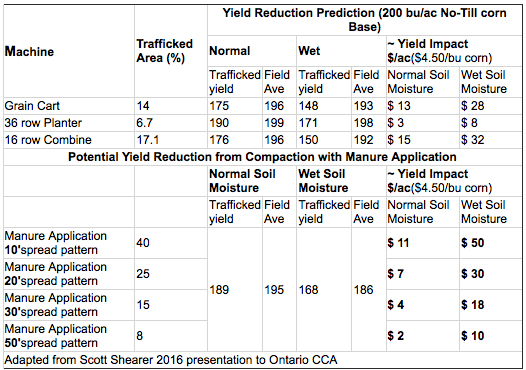
Equipment
Equipment
Manure Application
Re-evaluating the cost of compaction from manure application
How much does compaction really cost? Consider increasing the profitability of a wheat crop by adding the value of compaction-induced yield loss in corn resulting from spring applied manure.
March 28, 2018 by OSCIA
Healthy soils have a unique infrastructure of pores that vary in size and support the movement of air, water, earthworms and other soil micro-organisms and plant roots.
Healthy soils that allow maximum water infiltration will help maximize the soil’s water-holding capacity and will minimize water runoff that leads to soil erosion. The greater the number of small pores, the more consolidated the soil is and the less capacity the soil has for water infiltration.
What is compaction?
Compaction is a change in soil structure, including an increase in soil density. In compacted soils, the soil aggregates are pushed more tightly together which reduces the size and stability of the soil aggregates, the size of the pores and disrupts the continuity of those pores.
According to research from the University of Minnesota, the change in soil structure is complex. There is not a simple relationship between increased soil density and decreased crop yield.
The changes in soil structure affect the movement of water, air, roots, and soil organisms through the soil, so the effect on yield depends on the weather, the amount and depth of compaction, and the crop type.
What causes compaction?
Wheel traffic is the main cause of compaction on most farms. The amount of compaction depends on the size and weight of the equipment, the moisture level of the soil, and the type of soil (soils high in clay or low in organic matter compact more readily).
Table 1, with information adapted from Dr. S Shearer – University of Ohio, shows the potential economic impact of compaction from wheel traffic on normal and wet soils. It also considers the impact of wider spread pattern for manure application equipment on reducing wheel traffic-induced compaction.
Table 1: Yield Impact from Wheel Track Compaction on Normal and Wet Soils with Common Field Equipment and Varying Spread Widths of Manure Application Equipment

If the data collected by Dr. Scott Shearer of Ohio State University is extrapolated to calculate the cost of compaction on crop yield per acre, it would demonstrate a 6 bu/acre yield difference from wheel traffic in soils with normal moisture and a 27 bu/acre yield difference from wheel traffic in wet soils. At $4.50 /bu corn this would cost close to $ 50/acre with narrow width spread pattern manure application equipment. Wider spread pattern results in less wheel tracks and in less crop yield loss.
Many producers do not consider wheat to be an economical crop in the rotation. If the economics of crop production were not just based on the highest yield, but on the economics (including long term soil health) across the whole rotation, it would escalate the value of wheat in the rotation.
Beyond the advantages of increased yields for subsequent corn and soybean crops, documented by Dr. B. Deen at the University of Guelph, there are additional economic considerations.
The opportunity of manure application after July wheat harvest, into conditions with the lowest risk for compaction, and with the opportunity to add cover crops to alleviate consolidated soil and build aggregate stability give additional diversity and soil health advantages. Additionally, the opportunity to spread workload and equipment costs over the entire growing season (compared to a few weeks in spring and fall) provides additional advantages.
With larger fields and bigger field equipment, compaction issues will not disappear. Is it time to reconsider the options for reducing compaction on your farm?
References: Soil Compaction; Causes, Effects and Control https://www.extension.umn.edu/agriculture/soils/tillage/soil-compaction/